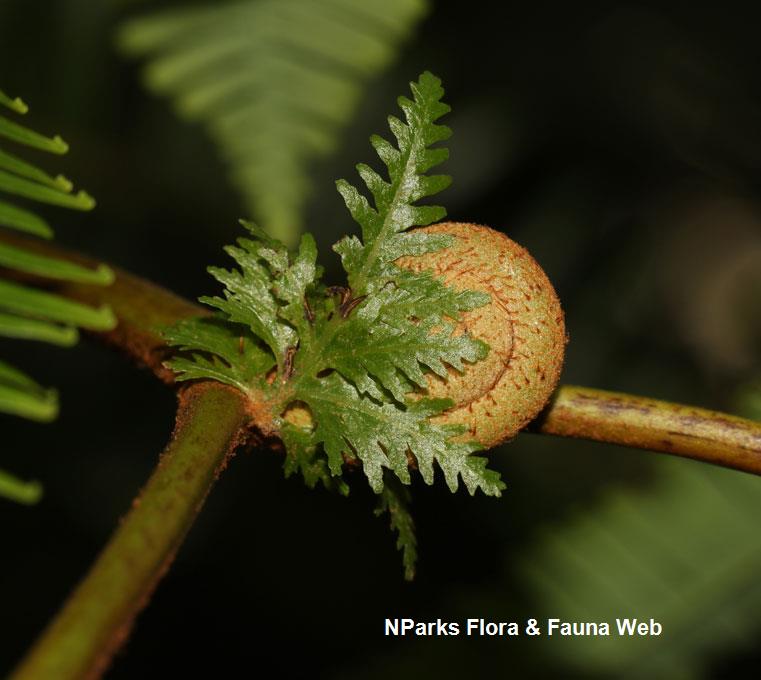.jpg)
Back
Sticherus truncatus (Willd.) Nakai
| Family Name: | Gleicheniaceae |
| Synonyms: | Gleichenia truncata (Willd.) Spreng., Gleichenia truncata (Willd.) Spreng. var. truncata |
Sticherus truncatus is a terrestrial fern native to Singapore. The whole frond and main branches are bilaterally symmetrical, each branch fork dichotomously several times. Except for the primary branch, the secondary and latter branches are leafy, covered in pairs of pinnae. Buds are covered in narrow brown scales, protected by 2 feathery 'stipules'. Often mistaken for a Dicranopteris species, this native fern can be distinguished by its leafy dichotomous branching.
Name
Classifications and Characteristics
| Plant Division | Ferns & Lycophytes (Non-Seed Vascular Plants) (Fern) |
|---|---|
| Plant Growth Form | Herbaceous Plant |
Biogeography
| Native Distribution | South China, Continental Southeast Asia and Malesia |
|---|---|
| Native Habitat | Terrestrial (Disturbed Area / Open Ground, Primary Rainforest, Secondary Rainforest) |
| Preferred Climate Zone | Tropical |
| Local Conservation Status | Native to Singapore (Vulnerable (VU)) |
Description and Ethnobotany
| Growth Form | It is a terrestrial fern forming weak self-supporting thickets or found scrambling upwards through taller vegetation, growing indefinitely in length. |
|---|---|
| Foliage | The whole frond and main branches are bilaterally symmetrical, each branch forks equally (dichotomous branching) several times. The primary branch is leafless, deeply lobed, while the secondary and latter branches are lined with pairs of pinnae. Dormant buds are covered in narrow brown scales, protected by 2 feathery 'stipules'. The ultimate branch bear deeply lobed, pinnatifid foliage with lobes vary in length even on the same branch between 20 - 50 mm long and 2.5 mm wide. |
| Reproductive Parts - non-flowering plant | The sori is round, produced on either sides of the blade in a single line. |
| Others - Plant Morphology | Rhizomes are long-creeping. |
| Habitat | Occurs on the edge of forest, 0 - 1600 m in thickets at higher altitudes, often growing with other 'Resam' species. |
| Similar | Sitcherus truncatus is similar to Dicranopteris species. The key differences are found in the dichotomous branching and shape of the 'stipules'. Apart from the main branch, the subsequent branches of Sticherus truncatus are leafy. Dormant buds are protected by 2 feathery 'stipules'. Unlike the Dicranopteris species where the branches are leafless, dormant buds are protected by lobed stipules. <1> <2> |
| Cultivation | It can be propagated by spores or rhizomes. |
Plant Care and Propagation
| Light Preference | Semi-Shade |
|---|---|
| Water Preference | Moderate Water |
| Plant Growth Rate | Fast to Moderate |
| Rootzone Tolerance | Moist Soils, Well-Drained Soils |
| Propagation Method | Spore, Storage Organ (Rhizome) |
Foliar
| Mature Foliage Colour(s) | Green |
|---|---|
| Foliar Type | Compound |
| Foliar Shape(s) | Non-Palm Foliage (Linear) |
| Foliar Apex - Tip | Acuminate, Rounded, Obtuse |
References
| References | <1> Holttum, R.E. (1959). Dicranopteris. In: Holttum, R.E. (ed.) Gleicheniaceae. Flora Malesiana, ser. 2, Pteridophyta, vol. 1, pt. 1, pp. 20-21. Leiden: Rijksherbarium. <2> Tagawa, M. & Iwatsuki, K. (1979). Flora of Thailand, vol. 3(1), pp. 53. Bangkok: Forest Herbarium, Department of National Parks, Wildlife and Plant Conservation. |
|---|
Image Repository
Others
| Master ID | 34309 |
|---|---|
| Species ID | 8722 |
| Flora Disclaimer | The information in this website has been compiled from reliable sources, such as reference works on medicinal plants. It is not a substitute for medical advice or treatment and NParks does not purport to provide any medical advice. Readers should always consult his/her physician before using or consuming a plant for medicinal purposes. |

.jpg)
.jpg)
.jpg)

.jpg)